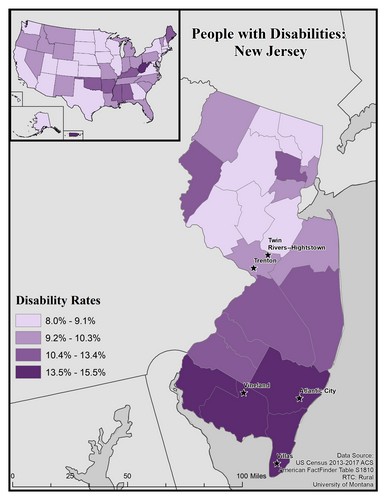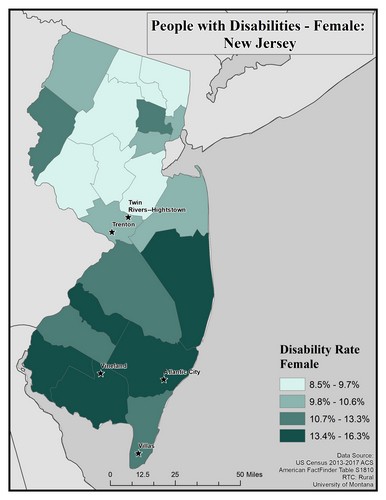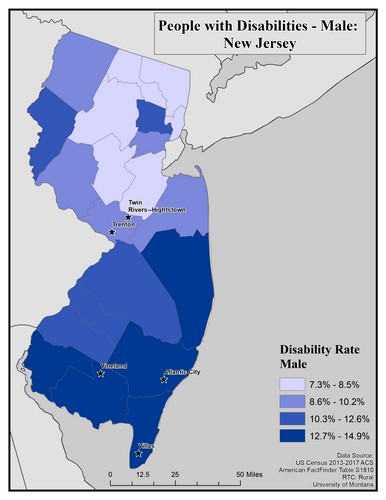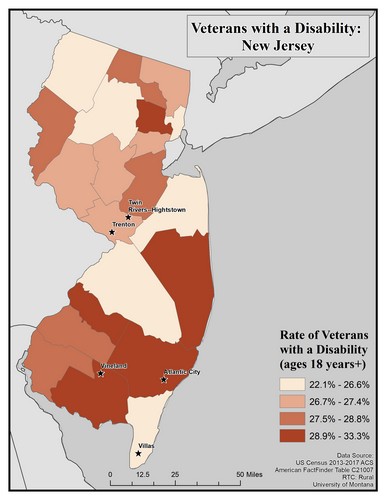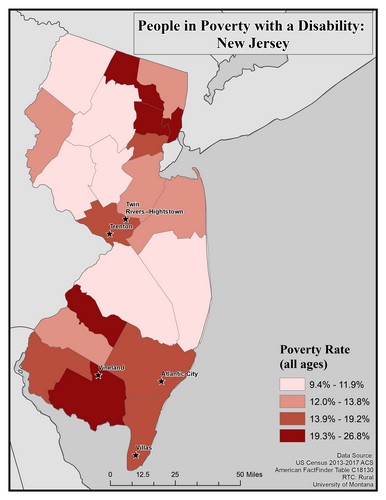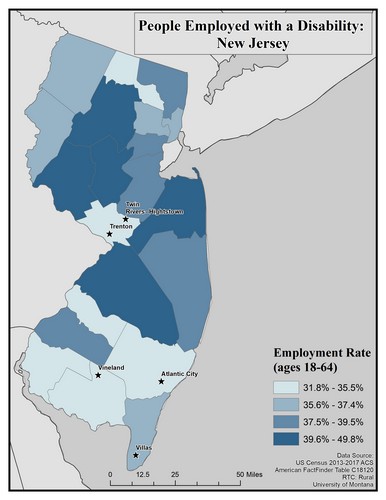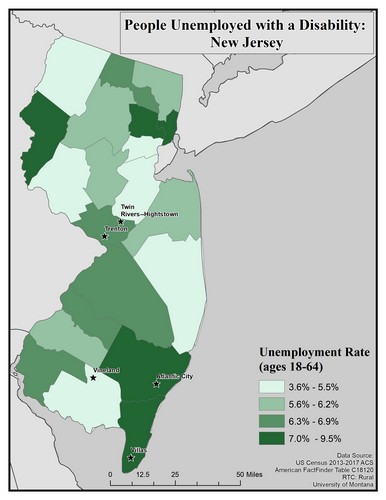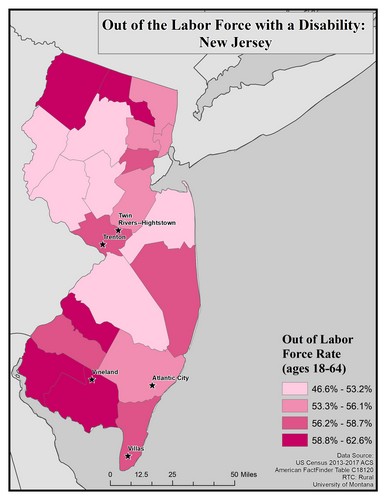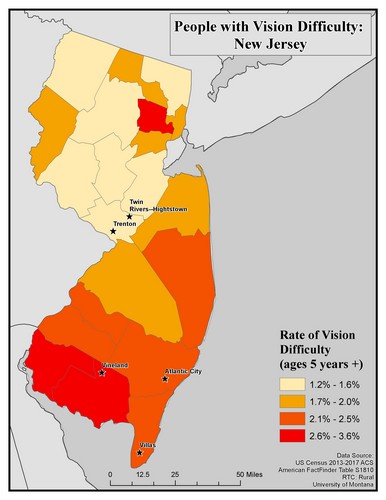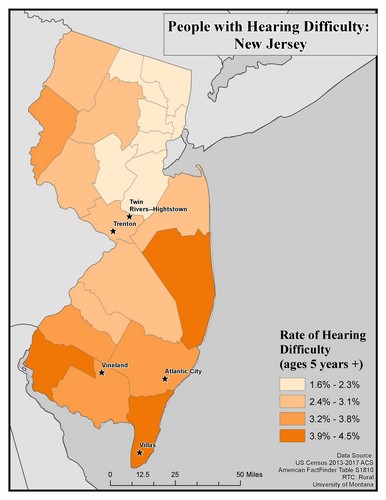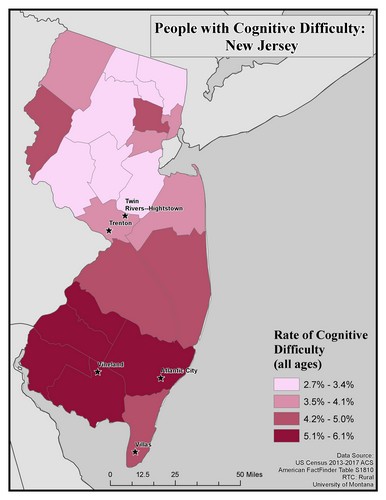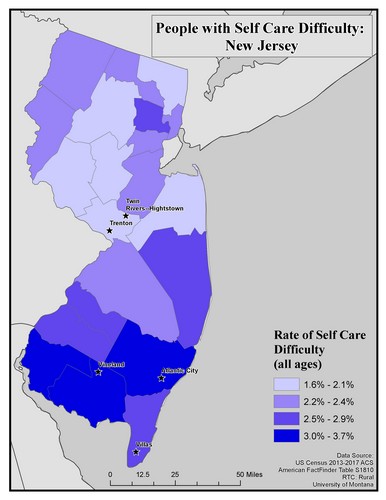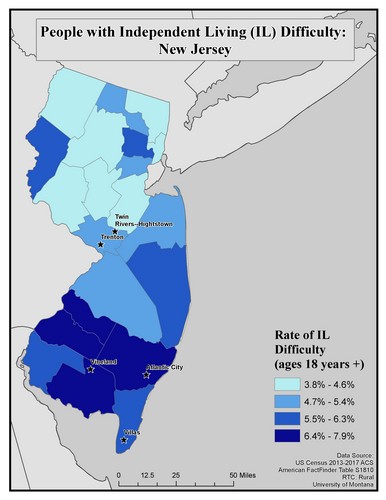New Jersey State Profile
The maps on this page explore the American Community Survey 5-year data (Table S1810) on disability by county.
The ACS does not directly measure disability. Instead, it uses a set of disability indicator questions related to difficulty and functional impairment to identify individuals who may experience a disability. If a respondent can answer “yes” to any disability question they are classified as having a disability.
Disability Rates: New Jersey
This map of New Jersey shows general rates of disability across the state at the county level. Disability rates are broken into four categories, from 8.0 to 15.5%.
All of New Jersey is considered urban, according to OMB 2015. The highest rates of disability, 13.5 to 15.5%, are in the southern part of the state, in the counties surrounding Villas, Atlantic City, and Vineland. The counties above those have slightly lower rates of 10.4 to 13.4%, and the counties surrounding Trenton and Twin Rivers/ Hightstown have rates of 9.2 to 10.3%. The rest of the state tends to have lower rates of 8.0 to 9.1%, though there are pockets of counties with higher rates.
In the upper corner of the map is an inset map of the United States showing how overall general disability rates in New Jersey compare to the rest of the United States. At the state level, disability rates in New Jersey are in the lowest category.
Map produced September 2019 based on 2013-2017 American Community Survey data.
- Click on the map for a larger, downloadable version.
- To browse or download the data used to make this map, use our Disability Data Lookup Tool.
This map of the state of New Jersey shows disability rate among females by county. Rates are broken into four categories from 8.5 to 16.3%.
The five largest urban areas (Atlantic City, Twin Rivers--Hightstown, Trenton, Vineland, and Villas) are labeled on the map.
Twin Rivers—Hightstown and Trenton are in a county with the second-lowest rate of 9.8 to 10.6%. Villas is in a county with the second-highest rate of 10.7 to 13.3%. Vineland and Atlantic City are in counties with the highest rate of 13.4 to 16.3%. Most of the counties with higher rate are in the south and east.
Map produced August 2020 based on 2013-2017 American Community Survey data.
- Click on the map for a larger, downloadable version.
- To browse or download the data used to make this map, use our Disability Data Lookup Tool.
- For information on how biological sex is used and defined in the ACS, see “American Community Survey and Puerto Rico Community Survey 2017 Subject Definitions” page 125.
This map of the state of New Jersey shows disability rate among males by county. Rates are broken into four categories from 7.3 to 14.9%.
The five largest urban areas (Atlantic City, Twin Rivers--Hightstown, Trenton, Vineland, and Villas) are labeled on the map.
Twin Rivers—Hightstown and Trenton are in a county with the second-lowest rate of 8.6 to 10.2%. Vineland, Atlantic City and Villas are in counties with the highest rate of 12.7 to 14.9%.
Map produced August 2020 based on 2013-2017 American Community Survey data.
- Click on the map for a larger, downloadable version.
- To browse or download the data used to make this map, use our Disability Data Lookup Tool.
- For information on how biological sex is used and defined in the ACS, see “American Community Survey and Puerto Rico Community Survey 2017 Subject Definitions” page 125.
This map explores the American Community Survey (ACS) 5-year data (Table S1810) on disability estimates.
The ACS asks a set of disability indicator questions to determine disability. If a respondent can answer “yes” to any disability question they are classified as having a disability. The data below are for ages 18 and over.
This map of the state of New Jersey shows rates of disability among veterans aged 18 and older by county. Rates are broken into four categories from 22.1 to 33.3%.
The five largest urban areas (Atlantic City, Twin Rivers--Hightstown, Trenton, Vineland, and Villas) are labeled on the map.
Villas is in a county with the lowest rate of 22.1 to 26.6%. Twin Rivers—Hightstown and Trenton are in a county with the second-lowest rate of 26.7 to 27.4%. Atlantic City and Vineland are in counties with the highest rate of 28.9 to 33.3%.
Map produced August 2020 based on 2013-2017 American Community Survey data.
- Click on the map for a larger, downloadable version.
- To browse or download the data used to make this map, use our Disability Data Lookup Tool.
This map of the state of New Jersey shows poverty rates among people with disabilities of all ages by county. Poverty rates are broken into four levels from 9.4 to 26.8%.
The five largest urban areas (Atlantic City, Twin Rivers--Hightstown, Trenton, Vineland, and Villas) are labeled on the map. Rates are mixed across the state.
Twin Rivers—Hightstown, Trenton, Atlantic City and Villas are in counties with the second-highest rate of 13.9 to 19.2%. Vineland is in a county with the highest rate of 19.3 to 26.8%.
Map produced August 2020 based on 2013-2017 American Community Survey data.
- Click on the map for a larger, downloadable version.
- To browse or download the data used to make this map, use our Disability Data Lookup Tool.
Employment: New Jersey
This map explores American Community Survey (ACS) 5-year data (Table C18120) employment estimates by disability type.
The ACS asks a set of disability indicator questions to determine disability. If a respondent can answer “yes” to any disability question they are classified as having a disability. The data below are for ages 18-64.
This map of New Jersey shows employment rates among people with disabilities. The data includes people ages 18 to 64. Rates are broken into four categories ranging from 31.8 to 49.8%.
The five largest urban areas (Atlantic City, Twin Rivers--Hightstown, Trenton, Vineland, and Villas) are labeled on the map to show if there are any differences between rates in urban compared to rural areas.
Villas is in a county with the second-lowest rates of 35.6 to 37.4%. The other four urban areas are in counties with the lowest rate of 31.8 to 35.5%.
Map produced August 2020 based on 2013-2017 American Community Survey data.
- Click on the map for a larger, downloadable version.
- To browse or download the data used to make this map, use our Disability Data Lookup Tool.
This map explores American Community Survey (ACS) 5-year data (Table C18120) employment estimates by disability type.
The ACS asks a set of disability indicator questions to determine disability. If a respondent can answer “yes” to any disability question they are classified as having a disability. The data below are for ages 18-64.
This map of New Jersey shows unemployment rates among people with disabilities. The data includes people ages 18 to 64. Rates are broken into four categories from 3.6 to 9.5%.
The five largest urban areas (Atlantic City, Twin Rivers--Hightstown, Trenton, Vineland, and Villas) are labeled on the map.
Vineland is in a county with the lowest rate of 3.6 to 5.5%. Twin Rivers—Hightstown and Trenton are in a county with the second-highest rate of 6.3 to 6.9%. Atlantic City and Villas are in counties with the highest rates of 7.0 to 9.5%.
Map produced August 2020 based on 2013-2017 American Community Survey data.
- Click on the map for a larger, downloadable version.
- To browse or download the data used to make this map, use our Disability Data Lookup Tool.
This map explores American Community Survey (ACS) 5-year data (Table C18120) employment estimates by disability type.
The ACS asks a set of disability indicator questions to determine disability. If a respondent can answer “yes” to any disability question they are classified as having a disability. The data below are for ages 18-64.
This map of New Jersey shows out of labor force rates among people with disabilities. The data includes people ages 18 to 64. Rates are broken into four categories from 46.6 to 62.6%.
The five largest urban areas (Atlantic City, Twin Rivers--Hightstown, Trenton, Vineland, and Villas) are labeled on the map to show if there are any differences between rates in urban compared to rural areas.
Atlantic City is in a county with the second-lowest rates of 53.3 to 56.1%. Twin Rivers—Hightstown, Trenton and Villas are in counties with the second-highest rate of 56.2 to 58.7%. Vineland is in a county with the highest rate of 58.8 to 62.6%.
Map produced August 2020 based on 2013-2017 American Community Survey data.
- Click on the map for a larger, downloadable version.
- To browse or download the data used to make this map, use our Disability Data Lookup Tool.
Disability Rates by Functional Limitation: New Jersey
This map explores the American Community Survey (ACS) 5-year data (Table S1810) on disability estimates by county.
For vision difficulty the ACS asks if a respondent is blind or has serious difficulty seeing, even when wearing glasses. If they answer “yes” they are classified as having a vision difficulty. This data is for all ages.
This map of the state of New Jersey shows rates of people with vision difficulty for ages 5 and older by county. Rates are broken into four categories from 1.2 to 3.6%.
The five largest urban areas (Atlantic City, Twin Rivers--Hightstown, Trenton, Vineland, and Villas) are labeled on the map.
Twin Rivers—Hightstown and Trenton are in a county with the lowest rate of 1.2 to 1.6%. Atlantic City and Villas are in counties with the second-highest rate of 2.1 to 2.5%. Vineland is in a county with the highest rate of 2.6 to 3.6%.
Map produced June 2020 based on 2013-2017 American Community Survey data.
- Click on the map for a larger, downloadable version.
- To browse or download the data used to make this map, use our Disability Data Lookup Tool.
This map explores the American Community Survey (ACS) 5-year data (Table S1810) on disability estimates by county.
For hearing difficulty the ACS asks if a respondent is deaf or has serious difficulty hearing. If they answer “yes” they are classified as having a hearing difficulty. This data is for all ages.
This map of the state of New Jersey shows rates of people with hearing difficulty for ages 5 and older by county. Rates are broken into four categories from 1.6 to 4.5%.
The five largest urban areas (Atlantic City, Twin Rivers--Hightstown, Trenton, Vineland, and Villas) are labeled on the map.
Twin Rivers—Hightstown and Trenton are in a county with the second-lowest rate of 2.4 to 3.1%. Atlantic City and Vineland are in counties with the second-highest rate of 3.2 to 3.8%. Villas is in a county with the highest rate of 3.9 to 4.5%.
Map produced June 2020 based on 2013-2017 American Community Survey data.
- Click on the map for a larger, downloadable version.
- To browse or download the data used to make this map, use our Disability Data Lookup Tool.
This map explores the American Community Survey (ACS) 5-year data (Table S1810) on disability estimates by county.
For cognitive difficulty the ACS asks because of a physical, mental, or emotional problem, does the respondent have difficulty remembering, concentrating, or making decisions. If they answer “yes” they are classified as having a cognitive difficulty. This data is for ages 5 and up.
This map of the state of New Jersey shows rates of people with cognitive difficulty by county. Rates are broken into four categories from 2.7 to 6.1%.
The five largest urban areas (Atlantic City, Twin Rivers--Hightstown, Trenton, Vineland, and Villas) are labeled on the map.
Twin Rivers—Hightstown and Trenton are in a county with the second-lowest rate of 3.5 to 4.1%. Villas is in a county with the second-highest rate of 4.2 to 5.0%. Atlantic City and Vineland are in counties with the highest rate of 5.1 to 6.1%.
Map produced June 2020 based on 2013-2017 American Community Survey data.
- Click on the map for a larger, downloadable version.
- To browse or download the data used to make this map, use our Disability Data Lookup Tool.
This map explores the American Community Survey (ACS) 5-year data (Table S1810) on disability estimates by county.
For ambulatory (i.e. mobility) difficulty the ACS asks if a respondent has serious difficulty walking or climbing stairs. If they answer “yes” they are classified as having a mobility difficulty. This data is for ages 5 and up.
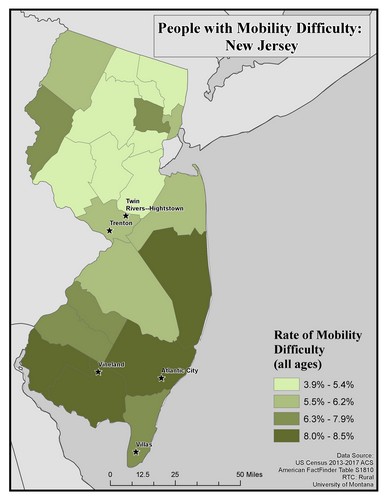 This map of the state of New Jersey shows rates of people with mobility difficulty for all ages by county. Rates are broken into four categories from 3.9 to 8.5%.
This map of the state of New Jersey shows rates of people with mobility difficulty for all ages by county. Rates are broken into four categories from 3.9 to 8.5%.
The five largest urban areas (Atlantic City, Twin Rivers--Hightstown, Trenton, Vineland, and Villas) are labeled on the map to show if there are any differences between rates of people with mobility difficulty in urban compared to rural areas.
Twin Rivers—Hightstown and Trenton are in a county with the second-lowest rate of 5.5 to 6.2%. Villas is in a county with the second-highest rate of 6.3 to 7.9%. Vineland and Atlantic City are in counties with the highest rate of 8.0 to 8.5%.
Map produced June 2020 based on 2013-2017 American Community Survey data.
- Click on the map for a larger, downloadable version.
- To browse or download the data used to make this map, use our Disability Data Lookup Tool.
This map explores the American Community Survey (ACS) 5-year data (Table S1810) on disability estimates by county.
For self-care difficulty the ACS asks if a respondent has difficulty bathing or dressing. If they answer “yes” they are classified as having a self-care difficulty. This data is for ages 5 and up.
This map of the state of New Jersey shows rates of people with self-care difficulty by county. Rates are broken into four categories from 1.6 to 3.7%.
The five largest urban areas (Atlantic City, Twin Rivers--Hightstown, Trenton, Vineland, and Villas) are labeled on the map.
Twin Rivers—Hightstown and Trenton are in a county with the lowest rate of 1.6 to 2.1%. Villas is in a county with the second-highest rate of 2.5 to 2.9%. Vineland and Atlantic City are in counties with the highest rate of 3.0 to 3.7%.
Map produced June 2020 based on 2013-2017 American Community Survey data.
- Click on the map for a larger, downloadable version.
- To browse or download the data used to make this map, use our Disability Data Lookup Tool.
This map explores the American Community Survey (ACS) 5-year data (Table S1810) on disability estimates by county.
For independent living difficulty the ACS asks because of a physical, mental, or emotional problem, does the respondent have difficulty doing errands alone such as visiting a doctor’s office or shopping. If they answer “yes” they are classified as having an independent living difficulty. This data is for ages 18 and up.
This map of the state of New Jersey shows rates of independent living (IL) difficulty for people 18 years of age and older by county. Rates are broken into four categories from 3.8 to 7.9%.
The five largest urban areas (Atlantic City, Twin Rivers--Hightstown, Trenton, Vineland, and Villas) are labeled on the map.
Twin Rivers—Hightstown and Trenton are in a county with the second-lowest rate of 4.7 to 5.4%. Villas is in a county with the second-highest rate of 5.5 to 6.3%. Atlantic City and Vineland are in counties with the highest rate of 6.4 to 7.9%.
Map produced June 2020 based on 2013-2017 American Community Survey data.
- Click on the map for a larger, downloadable version.
- To browse or download the data used to make this map, use our Disability Data Lookup Tool.

